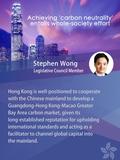As we continue to find our way around the COVID-19 pandemic, the climate crisis ahead of us will require far greater leadership and resilience. Last year, 137 countries and regions committed to net-zero pledges, meaning that Hong Kong and most of the world have less than 30 years to achieve carbon neutrality — at least, that is the goal.
![]()
With a global investment gap of $125 trillion and no silver bullet, many governments are looking for inspiration. Hong Kong, with its sizable capital markets, status as an international financial center, and gateway between China and the rest of the world, is well-positioned to lead the way.
The city has made significant efforts in developing itself as a green and sustainable finance center. For instance, the Hong Kong Monetary Authority has launched a spectrum of initiatives. This ranges from the Green and Sustainable Finance Grant Scheme, which provides subsidies to cover bond issuance and external review services, to the Centre for Green and Sustainable Finance, a cross-sector platform aimed at helping the financial industry manage risks and opportunities presented by climate change. Keeping up with global trends, the HKMA is also studying the application of internationally recognized climate-related disclosures as well as the localization of the Common Ground Taxonomy in Hong Kong.
One of the latest signs of progress is the release of a preliminary feasibility assessment of carbon market opportunities for Hong Kong by the Green and Sustainable Finance Cross-Agency Steering Group, which is co-chaired by the HKMA and the Securities and Futures Commission.
The carbon market is the marketplace to trade credits that allow companies or others to emit a certain amount of carbon dioxide with the goal of reducing overall emissions over time. At present, there are two types of carbon markets: compliance and voluntary. The former is regulated by mandatory national, regional, or international carbon reduction regimes, with a market value of $170 billion as of 2021. Meanwhile, the latter allows companies and individuals to purchase carbon offsets on a voluntary basis, and is comparatively much smaller, at $1 billion.

While the local carbon market is small and oligopolistic, Hong Kong is well-positioned to cooperate with the Chinese mainland to develop a Guangdong-Hong Kong-Macao Greater Bay Area carbon market, given its long-established reputation for upholding international standards and acting as a facilitator to channel global capital into the mainland. The nascent voluntary carbon market also presents a precious opportunity for Hong Kong to develop into a global voluntary carbon market.
With that being said, the uptake of carbon trading as well as other green finance opportunities cannot go far without addressing the elephant in the room, and that is the gap between the financial world and the real economy.
On one hand, there have been good efforts to strengthen Hong Kong into a green and sustainable financial hub. There has also been no shortage of demand for sustainable debt. Last year, the sustainable debt market issuance exceeded $50 billion in Hong Kong, which demonstrates the popularity of environmental, social, and governance borrowing.
On the other hand, there have also been good initiatives in key-carbon emitting industries such as the building and construction industry. From adopting innovative products such as electrical machinery to sustainable practices such as modular integrated construction methods, the industry has shown a relentless growth in green activity.
Yet, how we mobilize capital to major carbon-generating sectors in Hong Kong’s local context remains a missing link. And this is even more so for small to medium-sized enterprises that are a cornerstone of the economy. Last year, bank credit to the private nonfinancial sector was almost 269 percent of Hong Kong’s GDP. It is crucial to mobilize the banking system to support low-carbon transition in the real economy, especially in redirecting capital flow to environmentally responsible projects and innovative technologies.
Recently, one such attempt to connect the missing link was presented by the Construction Industry Council’s Sustainable Finance Certification Scheme, launched in November last year. The program is a first in the construction industry to provide a common framework for green-project owners that demonstrate compliance with international sustainable finance principles. It hopes to improve the project’s credibility to financial institutions and investors when applying for green loans, sustainability-linked loans, and other financial instruments.
But has this certification and the like really helped raise capital for green projects? While findings on whether green projects have an impact on banks’ credit risks remain mixed, we must ask ourselves the larger question: What considerations are in place, if any, when banks decide to loan?
Actualizing the concept of “carbon neutrality” in Hong Kong will take a whole-society approach with integrated efforts among all sectors. In the long run, if Hong Kong truly wants to lead the way as a green and sustainable center and have a real shot at achieving carbon neutrality, we must ensure that capital is mobilized, and more importantly, that it is mobilized to the people, products and projects that require it the most.
The author is a Legislative Council member.
The views do not necessarily reflect those of China Daily.


